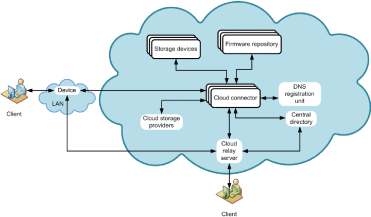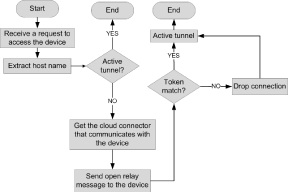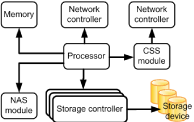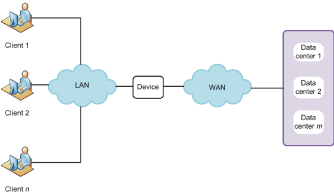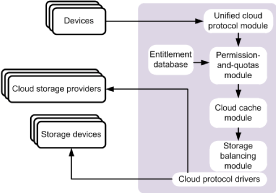
Mini Review
Austin J Robot & Autom. 2014;1(1): 4.
Enabling Robotic Devices in Cloud Environment
Bani Hashim AY*
Department of Robotics and Automation, University Teknikal Malaysia Melaka, Malaysia
*Corresponding author: Bani Hashim AY, Department of Robotics and Automation, University Teknikal Malaysia Melaka, 76100 Durian Tunggal, Melaka, Malaysia
Received: October 15, 2014; Accepted: November 28, 2014; Published: December 02, 2014
Abstract
Cloud computing paves the way for the large volume of data to generate accessible to individuals and enterprises. The results of phases from cloud computing, enormous data analytics, and mobile technologies contain helpful knowledge. A cloud-enabled robotic is about the interactions of software service providers, computers, sensor devices, and robots in the cloud environment. Cloud-enabled robots work within the manufacturing as a service infrastructure. The objective of this paper is to discuss the fundamentals of cloud computing where cloud-enable robotics somehow find its place in the cloud environment.
Keywords: Cloud-enabled Robotic; Manufacturing as a Service; Cloud Computing
Introduction
Cloud computing (CC) is about sharing of computer resources with the help of servers. It utilizes a computer to the Internet while accessing the shared resources that are accessible on demand. The term CC was derived from the symbol of the cloud which is often used to represent the Internet in forms of flowcharts and diagrams. Cloud computing is an emerging trend of online file access being utilized by businesses worldwide. It relates to the delivery of computing in sort of a service and not as a product. The importance of CC technology may be explained by its unparalleled prospects to save charges of investment and infrastructure. Cloud environment has unique architectures. Knowing the patterns would allow users to identify the requirement for infrastructure and framework, storage resource, and the associated technologies. Cloud computing infrastructure provides large-scale data storage, processing and distribution.
Map-reduce and NoSQL are the examples of data architectures used in connecting global information system to CC environment. Apache Hadoop, on the other hand, provides a platform for distributed and parallel data processing [1]. The variability in data volume results in variable computing and storage requirements. Therefore, optimizing the computing power with CPU and GPU-based cloud resources help resolve computationally-intensive applications when running on-demand [2]. On the other hand, efficient energy usage by augmenting energy and cost through worldwide allocation of computing resources assure high performance [3,4]. Global carbon dioxide emissions of the information and communication technology account for at most four percent. Mobile CC provides unlimited storage capabilities with energy-dissipation prevention [5].
The features for selecting an approach to data stream processing include interoperability, data model, programming language, and security. How data is being exchanged will depend on the data stream processing, data management, and semantics of programming languages. It is known that devices with heterogeneous hardware and software characteristics are not able to interact among them [6]. Semantic models may be used to solve some of the issues where they would ease the interoperability, integration and monitoring of knowledge-based systems. In addition, they allow modeling for logical restrictions on data while the linked data enable the publication of new data and information. Advances in semantic technologies, for instance, are the Linked Data that provides new ways of data visualization, and the RDF Data Cube Vocabulary that allows publication of statistical data [7].
A virtual environment requires tools that enable worldwide collaboration and remote processing. One of the collaborative features is such that only one remote shared display for all participants. Worldwide collaboration in projects and remote processing of data requires a service-oriented architecture that results in the creation of collaborative virtual environments, Analytics-as-a-Service, and digital ecosystem. The military, for instance, applies the DIS/HLA IEEE standard in a collaborative environment [8].
It is important to have the design of an architecture that allows devices with different and heterogeneous hardware and software characteristics to interact among them efficiently. In fact, these differences should be transparent to the end user and this should guarantee to access controls and security privileges. It is because information leakage on uploading to manage domains and stolen sensitive data from the domains are the issues in CC infrastructure, in terms of, security. The runtime resource configurations such as the types and speed of these applications need to be evaluated [9]. Sensitive data have to be encrypted before uploading onto the cloud servers. A storage system based on My SQL and together with Crypt DB may be used to protect and secure the data [6].
Cloud-enabled Robot Devices
Privacy
There is an issue of a new generation of network-centric applications that collects data rampantly since they are increasingly intelligent and autonomous. As a result, personal interaction with machines and robots will affect privacy. It is the user’s responsibility for the behavior of robots to the liability for harm provoked by animals, children, or employees. In fact, care should be taken on the different ways in which humans will treat, train, or manage their robots-in-the-cloud. Moreover, how the human-robot interaction may affect the multiple types of information that are appropriate to reveal, share, or transfer, in a given context [10].
Manufacturing as a service infrastructure
Cloud-enabled robotic works within the manufacturing as a service (MaaS) infrastructure. A generalized MaaS infrastructure is shown in Figure 1. This infrastructure permits individual plants to be interfaced to one source that is MaaS where the information is being shared. An industrial robot may be cloud-enabled through a cloud environment.
Figure 1: A general representation of MaaS infrastructure and how this infrastructure is linked to individual plants within which a robot may become enabled through cloud environment (figure redrawn based on source [11]).
Mining huge data from the cloud environment may help to improve robot interactions and decision making, hence Robot as a Service (RaaS). Remote Brain, Big Data and Shared Knowledge-base, Collective Learning, Intelligence and Behavior, and Cloud architectures are the concepts in cloud environment that would improve the performance of cloud robotics [11].
Methods
The interactions of software service providers, computers, sensor devices, and robots in the cloud environment is a cloud-enabled robotic. It has three layers [12]:
- Cloud service layer-application services that provide interfaces to be accessed by the robots
- Communication and collaboration layer-a middleware which uses a message-based mechanism to manage the communication between cloud services and robots, and
- Robot control layer-functions and hardware capability of a robot
The robot interfaces are realized through application services in the cloud service layer. The communication between cloud services and robots is realized through a middleware that is the cloud collaboration framework where a message-based mechanism manages the communication. The service component executes the task coordination and information sharing in the framework. A robot agent is an actual robot shown as a node in a computer program where it functions within the robot control layer with a reasoning capability [12].
A cloud relay server is required for communication over an internet connection. At least one client must present when communication takes place where Figure 2 exhibits the clients access the cloud system. The steps for enabling a remote access to a cloud-enable network (CEN) device are shown in Figure 3 and as explained [13]:
Figure 2: A remote access for cloud-enabled network devices (figure redrawn based on source [12]).
Figure 3: The process for enabling a remote access to a network attached storage device that provides cloud services (figure redrawn based on source [13]).
- A client requests to access to a user interface.
- The CEN device is connected in a local area network (LAN).
- A designated host name is used to request to detect a cloud connector (CCN).
- The CCN communicates with a CEN device by sending an open relay message over a management link.
- A secure tunnel between the CR serve and the CEN device is established.
- A safe connection between the client and the CEN device over the internet is enabled.
A network attached storage (NAS) performs network attached storage operations with cloud storage services where Figure 4 depicts its block the interconnection of relevant modules. A NAS device has the following components and functionality [14]:
Figure 4: The block diagram of network attached storage (figure redrawn based on source [14]).
- There should be at least one network controller.
- The network controller assists in communication with a group of clients over a LAN and with a cloud storage service(CSS) over a wide area network (WAN).
- There is a group of storage devices for locally storing data in the device.
- There is a CSS module for at least synchronizing between data locally stored in the group of storage devices and data stored in the CSS.
- There is a processor for enabling the group of clients to perform file-based operations on the device using a file sharing protocol.
A cloud connector is used to optimize a cloud service. It is a software component integrated with enterprise routing platforms. Some of the commercially available connectors are the products by Etherios, Cisco, and Mulesoft (https://www.etherios.com/, https:// www.cisco.com/, https://www.vmware.com/, https://www.mulesoft. com/, respectively). The CCN block diagram is shown in Figure 5 and it complies with the following setup rules [15]:
Figure 5: A storage network system (figure redrawn based on source [15]).
Figure 6: A block diagram of a cloud connector (figure redrawn based on source [15]).
- A united cloud protocol module is required for communication.
- The communication takes place between the CED device and the NAS device through a cloud transport protocol.
- A group of cloud protocol drivers for interfacing with at least one of a group of storage devices and a number of cloud storage providers is needed.
- The group of storage devices and the group of cloud storage providers are part of the CSS.
- A permissions-and-quotas enforcement module for enforcing access control to data blocks stored in at least one the group of storage devices and the group of cloud storage providers of the CSS is required.
Summary
Cloud-enabled robotic works within the manufacturing infrastructure as a service. Huge data that is stored in the cloud environment allows a group of robots to mine relevant data and use them according to predefined tasks for unique manufacturing operations. In doing so, the data gathered from multiple sets of sensors and transducers belong to a group robot are uploaded to the storage devices through cloud connectors as shared data or information. Depending on the current operation, a robot that is a member of the group will download packets of data or information from the cloud. The data will then be used to perform preprogrammed tasks or to create decisions for the upcoming sequences of operation.
References
- Gao S, Li L, Li W, Janowicz K, Zhang Y. Constructing gazetteers from volunteered Big Geo-Data based on Hadoop. Comput Environ Urban Syst. 2014.
- Ebejer JP, Fulle S, Morris GM, Finn PW. The emerging role of cloud computing in molecular modelling. J Mol Graph Model. 2013; 44: 177-187.
- Addis B, Ardagna D, Capone A, Carello G. Energy-aware joint management of networks and Cloud infrastructures. Comput Networks. 2014; 70: 75–95.
- Sultan N. Cloud computing: A democratizing force? Int J Inf Manage. 2013; 33: 810–815.
- Aminzadeh N, Sanaei Z, Ab Hamid SH. Mobile storage augmentation in mobile cloud computing: Taxonomy, approaches, and open issues. Simul Model Pract Theory. 2014.
- Castiglione A, Pizzolante R, De Santis A, Carpentieri B, Castiglione A, Palmieri F. Cloud-based adaptive compression and secure management services for 3D healthcare data. Futur Gener Comput Syst. 2014.
- Kourtesis D, Alvarez-Rodríguez JM, Paraskakis I. Semantic-based QoS management in cloud systems: Current status and future challenges. Futur Gener Comput Syst. 2014; 32: 307–323.
- Belaud J-P, Negny S, Dupros F, Michéa D, Vautrin B. Collaborative simulation and scientific big data analysis: Illustration for sustainability in natural hazards management and chemical process engineering. Comput Ind. 2014; 65: 521–535.
- Li R, Xu Z, Kang W, Yow KC, Xu C-Z. Efficient multi-keyword ranked query over encrypted data in cloud computing. Futur Gener Comput Syst. 2014; 30: 179–190.
- Pagallo U. Robots in the cloud with privacy: A new threat to data protection? Comput Law Secur Rev. 2013; 29: 501–508.
- Qureshi B, Koubâa A. Five Traits of Performance Enhancement Using Cloud Robotics: A Survey. Procedia Comput Sci. 2014; 37: 220–227.
- Mateo RMA. Scalable Adaptive Group Communication for Collaboration Framework of Cloud-enabled Robots. Procedia Comput Sci. 2013; 22: 1239–1248.
- Brand A. Remote access service for cloud-enabled network devices. Israel: United States Patent and Trademark Office; US 2013/0041931 A1. 2013.
- Brand A. Storage device and method thereof for integrating network attached storage with cloud storage services. Israel: United States Patent and Trademark Office; US 2010/0161759 A1. 2010.
- Brand A. Cloud connector for interfacing between a network attached storage device and a cloud storage system. Israel: United States Patent and Trademark Office; US 2011/0276713 A1. 2011.

